Enterprise Architecture Applications: Commonwealth Bank ERP Report
VerifiedAdded on 2020/04/07
|13
|4288
|57
Report
AI Summary
This report analyzes the implementation of Enterprise Resource Planning (ERP) systems at Commonwealth Bank of Australia, a major financial institution. It addresses the challenges the bank faces due to its growth and the need to integrate and synchronize various systems. The report emphasizes the importance of IT alignment with business strategy, illustrating how ERP, specifically the SAP platform, can help achieve business goals by improving customer service, streamlining operations, and enhancing risk management. It includes a strategy map to visualize the IT alignment process and discusses the benefits of an integrated ERP system for a financial institution, highlighting the need for a centralized database and efficient data management. The study underscores the significance of strategic alignment between IT and business objectives, offering a framework for optimizing IT investments and improving overall organizational performance.
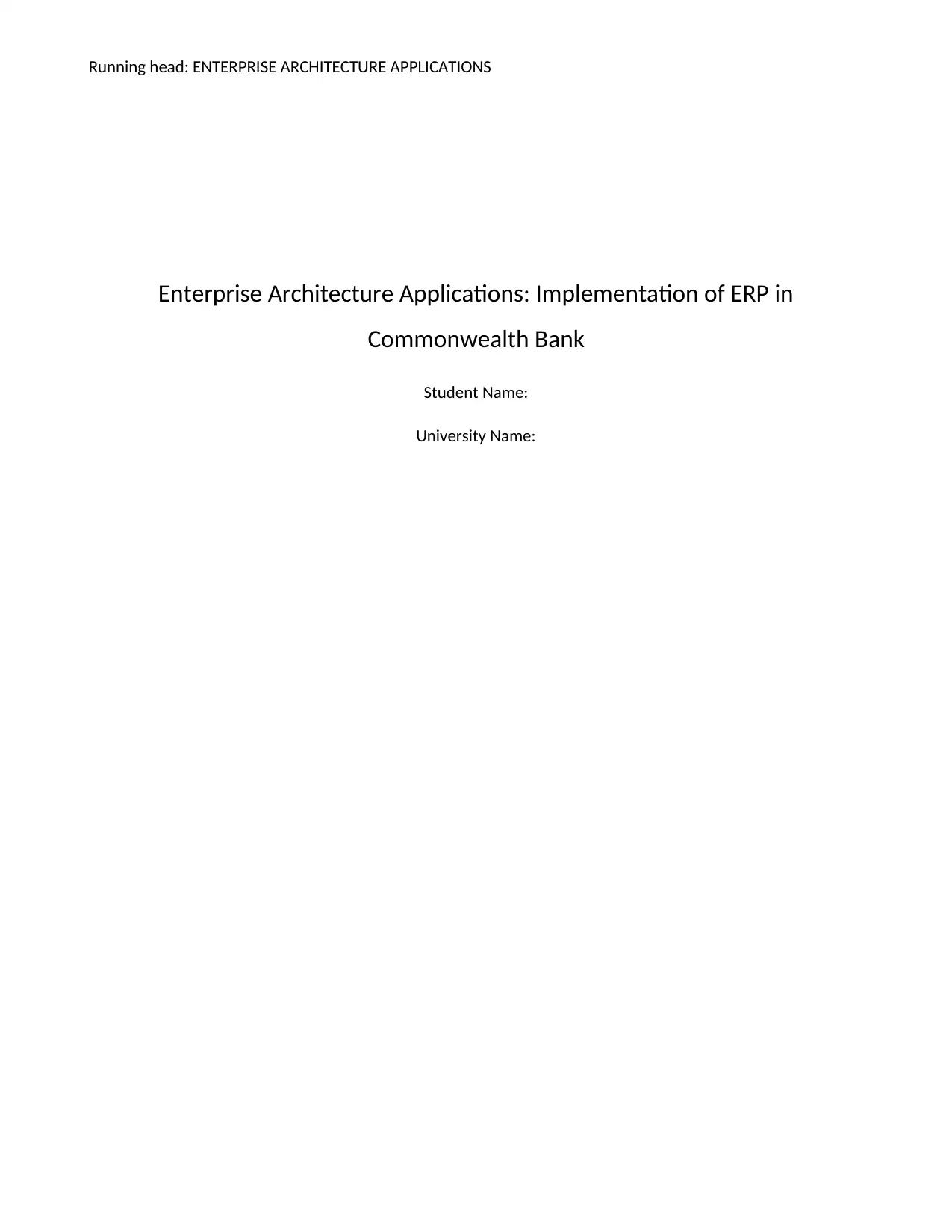
Running head: ENTERPRISE ARCHITECTURE APPLICATIONS
Enterprise Architecture Applications: Implementation of ERP in
Commonwealth Bank
Student Name:
University Name:
Enterprise Architecture Applications: Implementation of ERP in
Commonwealth Bank
Student Name:
University Name:
Paraphrase This Document
Need a fresh take? Get an instant paraphrase of this document with our AI Paraphraser
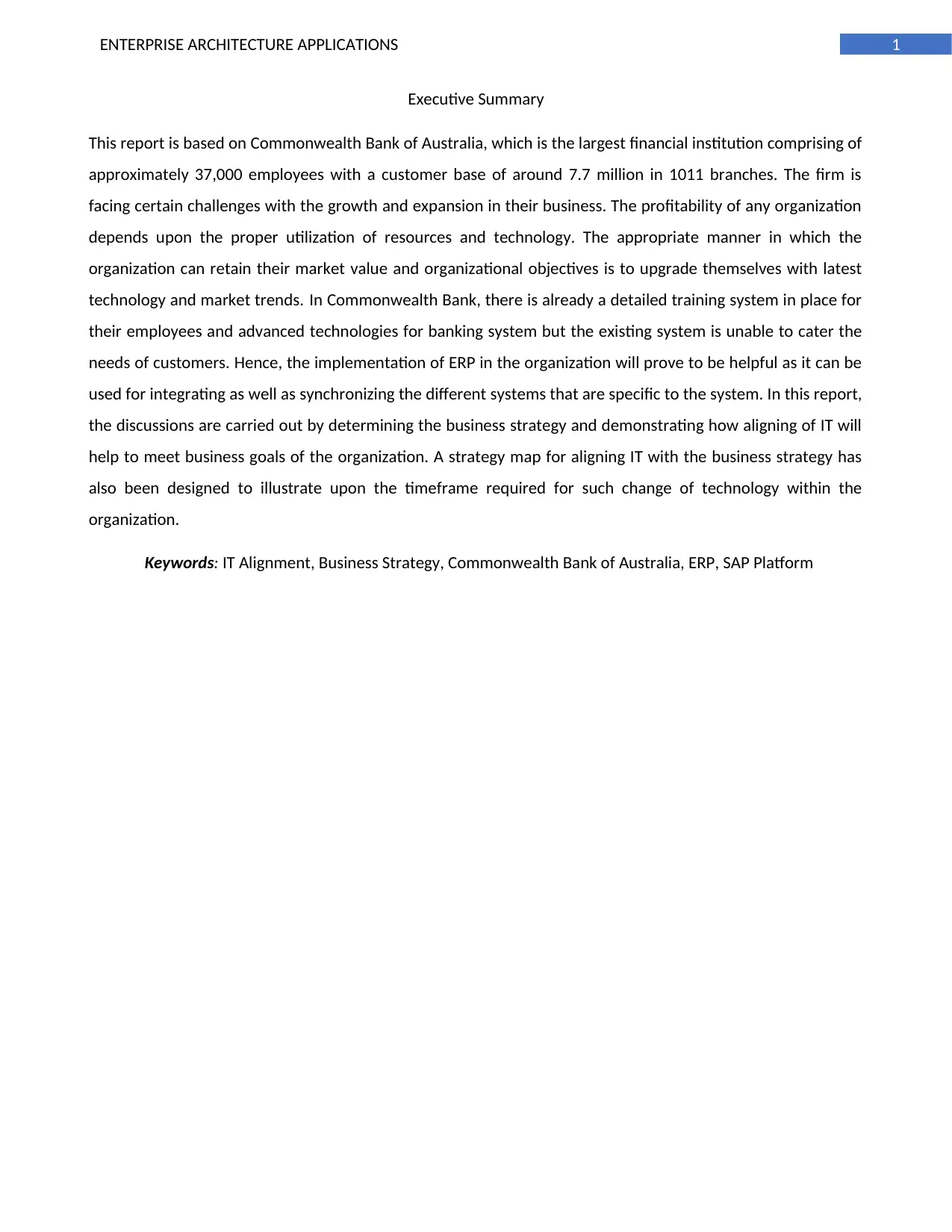
1ENTERPRISE ARCHITECTURE APPLICATIONS
Executive Summary
This report is based on Commonwealth Bank of Australia, which is the largest financial institution comprising of
approximately 37,000 employees with a customer base of around 7.7 million in 1011 branches. The firm is
facing certain challenges with the growth and expansion in their business. The profitability of any organization
depends upon the proper utilization of resources and technology. The appropriate manner in which the
organization can retain their market value and organizational objectives is to upgrade themselves with latest
technology and market trends. In Commonwealth Bank, there is already a detailed training system in place for
their employees and advanced technologies for banking system but the existing system is unable to cater the
needs of customers. Hence, the implementation of ERP in the organization will prove to be helpful as it can be
used for integrating as well as synchronizing the different systems that are specific to the system. In this report,
the discussions are carried out by determining the business strategy and demonstrating how aligning of IT will
help to meet business goals of the organization. A strategy map for aligning IT with the business strategy has
also been designed to illustrate upon the timeframe required for such change of technology within the
organization.
Keywords: IT Alignment, Business Strategy, Commonwealth Bank of Australia, ERP, SAP Platform
Executive Summary
This report is based on Commonwealth Bank of Australia, which is the largest financial institution comprising of
approximately 37,000 employees with a customer base of around 7.7 million in 1011 branches. The firm is
facing certain challenges with the growth and expansion in their business. The profitability of any organization
depends upon the proper utilization of resources and technology. The appropriate manner in which the
organization can retain their market value and organizational objectives is to upgrade themselves with latest
technology and market trends. In Commonwealth Bank, there is already a detailed training system in place for
their employees and advanced technologies for banking system but the existing system is unable to cater the
needs of customers. Hence, the implementation of ERP in the organization will prove to be helpful as it can be
used for integrating as well as synchronizing the different systems that are specific to the system. In this report,
the discussions are carried out by determining the business strategy and demonstrating how aligning of IT will
help to meet business goals of the organization. A strategy map for aligning IT with the business strategy has
also been designed to illustrate upon the timeframe required for such change of technology within the
organization.
Keywords: IT Alignment, Business Strategy, Commonwealth Bank of Australia, ERP, SAP Platform
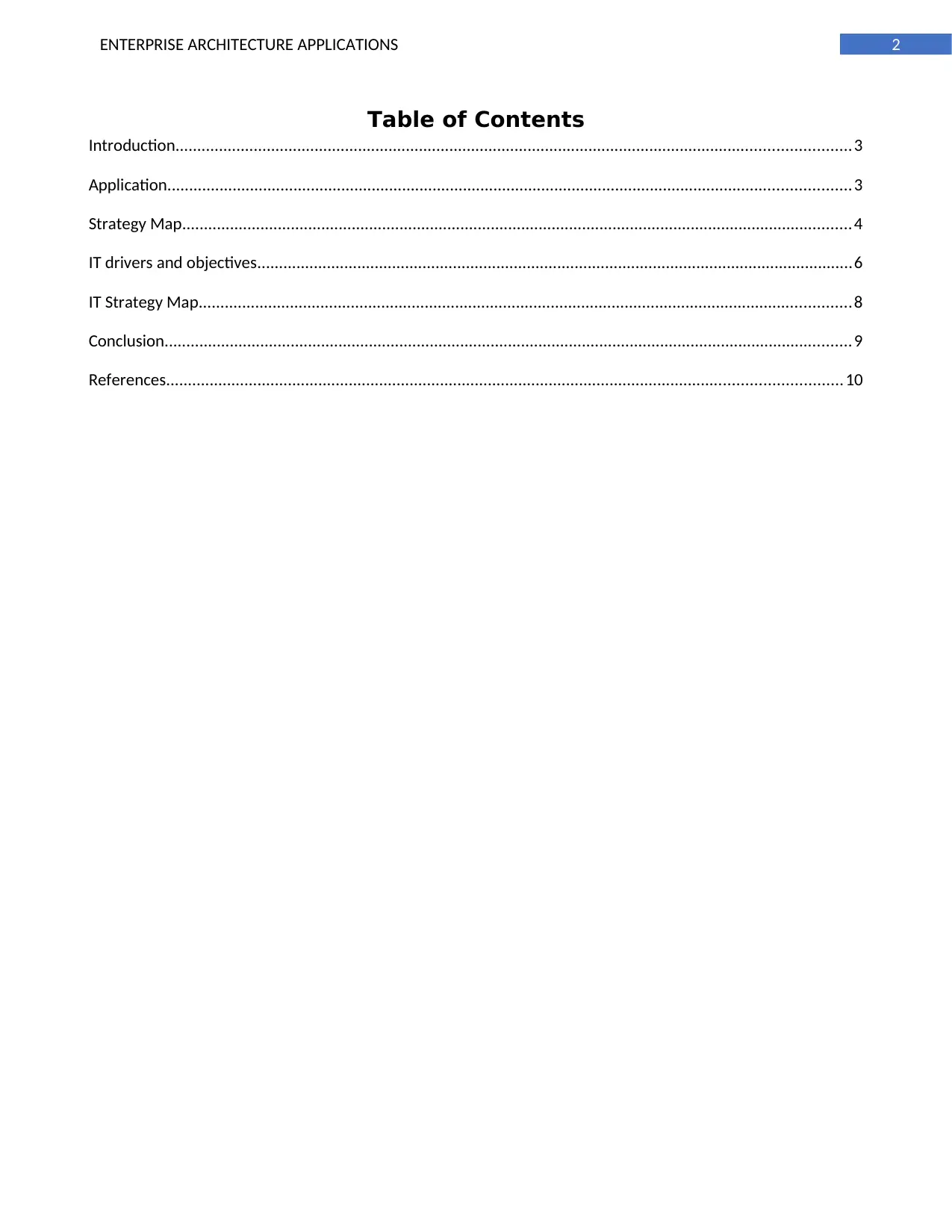
2ENTERPRISE ARCHITECTURE APPLICATIONS
Table of Contents
Introduction...........................................................................................................................................................3
Application.............................................................................................................................................................3
Strategy Map..........................................................................................................................................................4
IT drivers and objectives.........................................................................................................................................6
IT Strategy Map......................................................................................................................................................8
Conclusion..............................................................................................................................................................9
References...........................................................................................................................................................10
Table of Contents
Introduction...........................................................................................................................................................3
Application.............................................................................................................................................................3
Strategy Map..........................................................................................................................................................4
IT drivers and objectives.........................................................................................................................................6
IT Strategy Map......................................................................................................................................................8
Conclusion..............................................................................................................................................................9
References...........................................................................................................................................................10
⊘ This is a preview!⊘
Do you want full access?
Subscribe today to unlock all pages.

Trusted by 1+ million students worldwide
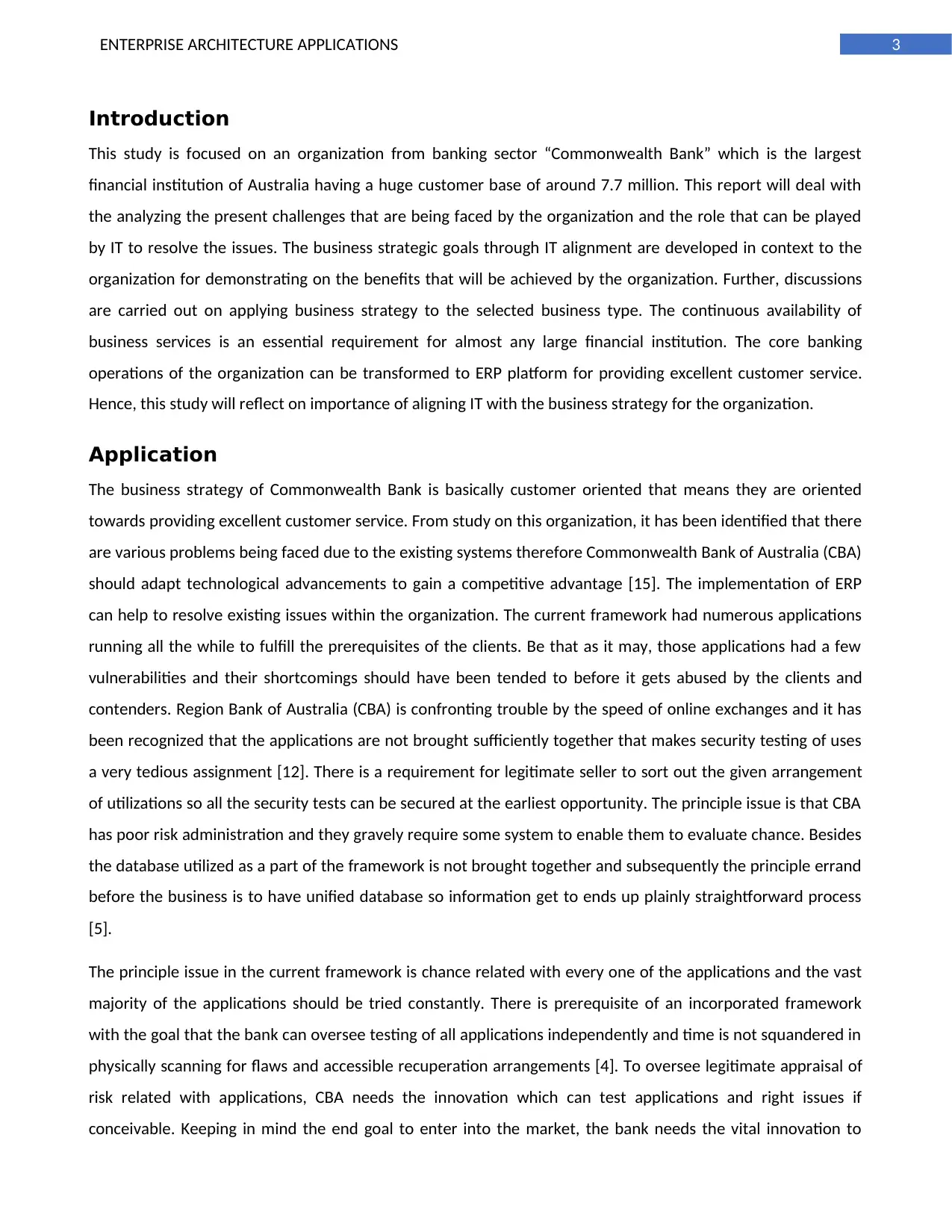
3ENTERPRISE ARCHITECTURE APPLICATIONS
Introduction
This study is focused on an organization from banking sector “Commonwealth Bank” which is the largest
financial institution of Australia having a huge customer base of around 7.7 million. This report will deal with
the analyzing the present challenges that are being faced by the organization and the role that can be played
by IT to resolve the issues. The business strategic goals through IT alignment are developed in context to the
organization for demonstrating on the benefits that will be achieved by the organization. Further, discussions
are carried out on applying business strategy to the selected business type. The continuous availability of
business services is an essential requirement for almost any large financial institution. The core banking
operations of the organization can be transformed to ERP platform for providing excellent customer service.
Hence, this study will reflect on importance of aligning IT with the business strategy for the organization.
Application
The business strategy of Commonwealth Bank is basically customer oriented that means they are oriented
towards providing excellent customer service. From study on this organization, it has been identified that there
are various problems being faced due to the existing systems therefore Commonwealth Bank of Australia (CBA)
should adapt technological advancements to gain a competitive advantage [15]. The implementation of ERP
can help to resolve existing issues within the organization. The current framework had numerous applications
running all the while to fulfill the prerequisites of the clients. Be that as it may, those applications had a few
vulnerabilities and their shortcomings should have been tended to before it gets abused by the clients and
contenders. Region Bank of Australia (CBA) is confronting trouble by the speed of online exchanges and it has
been recognized that the applications are not brought sufficiently together that makes security testing of uses
a very tedious assignment [12]. There is a requirement for legitimate seller to sort out the given arrangement
of utilizations so all the security tests can be secured at the earliest opportunity. The principle issue is that CBA
has poor risk administration and they gravely require some system to enable them to evaluate chance. Besides
the database utilized as a part of the framework is not brought together and subsequently the principle errand
before the business is to have unified database so information get to ends up plainly straightforward process
[5].
The principle issue in the current framework is chance related with every one of the applications and the vast
majority of the applications should be tried constantly. There is prerequisite of an incorporated framework
with the goal that the bank can oversee testing of all applications independently and time is not squandered in
physically scanning for flaws and accessible recuperation arrangements [4]. To oversee legitimate appraisal of
risk related with applications, CBA needs the innovation which can test applications and right issues if
conceivable. Keeping in mind the end goal to enter into the market, the bank needs the vital innovation to
Introduction
This study is focused on an organization from banking sector “Commonwealth Bank” which is the largest
financial institution of Australia having a huge customer base of around 7.7 million. This report will deal with
the analyzing the present challenges that are being faced by the organization and the role that can be played
by IT to resolve the issues. The business strategic goals through IT alignment are developed in context to the
organization for demonstrating on the benefits that will be achieved by the organization. Further, discussions
are carried out on applying business strategy to the selected business type. The continuous availability of
business services is an essential requirement for almost any large financial institution. The core banking
operations of the organization can be transformed to ERP platform for providing excellent customer service.
Hence, this study will reflect on importance of aligning IT with the business strategy for the organization.
Application
The business strategy of Commonwealth Bank is basically customer oriented that means they are oriented
towards providing excellent customer service. From study on this organization, it has been identified that there
are various problems being faced due to the existing systems therefore Commonwealth Bank of Australia (CBA)
should adapt technological advancements to gain a competitive advantage [15]. The implementation of ERP
can help to resolve existing issues within the organization. The current framework had numerous applications
running all the while to fulfill the prerequisites of the clients. Be that as it may, those applications had a few
vulnerabilities and their shortcomings should have been tended to before it gets abused by the clients and
contenders. Region Bank of Australia (CBA) is confronting trouble by the speed of online exchanges and it has
been recognized that the applications are not brought sufficiently together that makes security testing of uses
a very tedious assignment [12]. There is a requirement for legitimate seller to sort out the given arrangement
of utilizations so all the security tests can be secured at the earliest opportunity. The principle issue is that CBA
has poor risk administration and they gravely require some system to enable them to evaluate chance. Besides
the database utilized as a part of the framework is not brought together and subsequently the principle errand
before the business is to have unified database so information get to ends up plainly straightforward process
[5].
The principle issue in the current framework is chance related with every one of the applications and the vast
majority of the applications should be tried constantly. There is prerequisite of an incorporated framework
with the goal that the bank can oversee testing of all applications independently and time is not squandered in
physically scanning for flaws and accessible recuperation arrangements [4]. To oversee legitimate appraisal of
risk related with applications, CBA needs the innovation which can test applications and right issues if
conceivable. Keeping in mind the end goal to enter into the market, the bank needs the vital innovation to
Paraphrase This Document
Need a fresh take? Get an instant paraphrase of this document with our AI Paraphraser
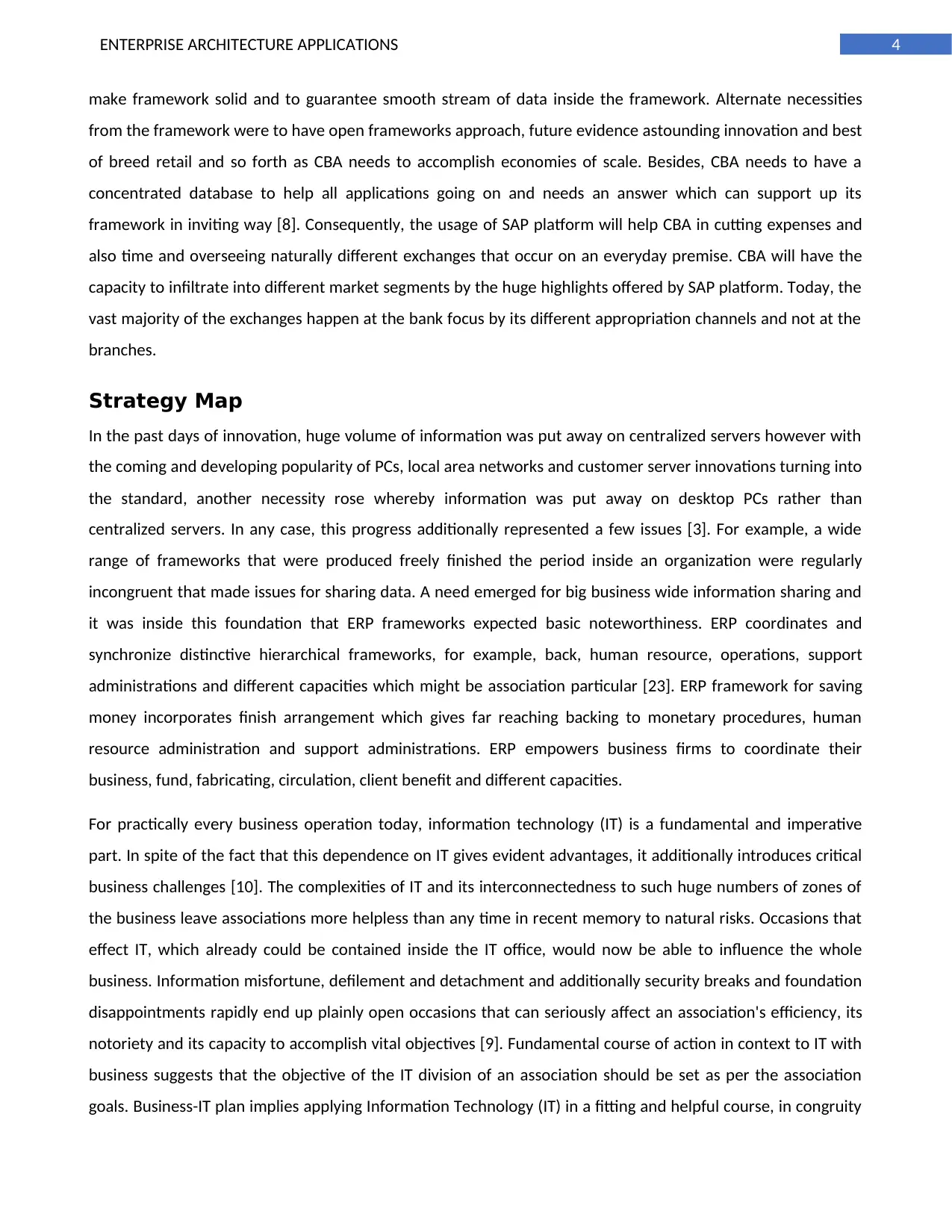
4ENTERPRISE ARCHITECTURE APPLICATIONS
make framework solid and to guarantee smooth stream of data inside the framework. Alternate necessities
from the framework were to have open frameworks approach, future evidence astounding innovation and best
of breed retail and so forth as CBA needs to accomplish economies of scale. Besides, CBA needs to have a
concentrated database to help all applications going on and needs an answer which can support up its
framework in inviting way [8]. Consequently, the usage of SAP platform will help CBA in cutting expenses and
also time and overseeing naturally different exchanges that occur on an everyday premise. CBA will have the
capacity to infiltrate into different market segments by the huge highlights offered by SAP platform. Today, the
vast majority of the exchanges happen at the bank focus by its different appropriation channels and not at the
branches.
Strategy Map
In the past days of innovation, huge volume of information was put away on centralized servers however with
the coming and developing popularity of PCs, local area networks and customer server innovations turning into
the standard, another necessity rose whereby information was put away on desktop PCs rather than
centralized servers. In any case, this progress additionally represented a few issues [3]. For example, a wide
range of frameworks that were produced freely finished the period inside an organization were regularly
incongruent that made issues for sharing data. A need emerged for big business wide information sharing and
it was inside this foundation that ERP frameworks expected basic noteworthiness. ERP coordinates and
synchronize distinctive hierarchical frameworks, for example, back, human resource, operations, support
administrations and different capacities which might be association particular [23]. ERP framework for saving
money incorporates finish arrangement which gives far reaching backing to monetary procedures, human
resource administration and support administrations. ERP empowers business firms to coordinate their
business, fund, fabricating, circulation, client benefit and different capacities.
For practically every business operation today, information technology (IT) is a fundamental and imperative
part. In spite of the fact that this dependence on IT gives evident advantages, it additionally introduces critical
business challenges [10]. The complexities of IT and its interconnectedness to such huge numbers of zones of
the business leave associations more helpless than any time in recent memory to natural risks. Occasions that
effect IT, which already could be contained inside the IT office, would now be able to influence the whole
business. Information misfortune, defilement and detachment and additionally security breaks and foundation
disappointments rapidly end up plainly open occasions that can seriously affect an association's efficiency, its
notoriety and its capacity to accomplish vital objectives [9]. Fundamental course of action in context to IT with
business suggests that the objective of the IT division of an association should be set as per the association
goals. Business-IT plan implies applying Information Technology (IT) in a fitting and helpful course, in congruity
make framework solid and to guarantee smooth stream of data inside the framework. Alternate necessities
from the framework were to have open frameworks approach, future evidence astounding innovation and best
of breed retail and so forth as CBA needs to accomplish economies of scale. Besides, CBA needs to have a
concentrated database to help all applications going on and needs an answer which can support up its
framework in inviting way [8]. Consequently, the usage of SAP platform will help CBA in cutting expenses and
also time and overseeing naturally different exchanges that occur on an everyday premise. CBA will have the
capacity to infiltrate into different market segments by the huge highlights offered by SAP platform. Today, the
vast majority of the exchanges happen at the bank focus by its different appropriation channels and not at the
branches.
Strategy Map
In the past days of innovation, huge volume of information was put away on centralized servers however with
the coming and developing popularity of PCs, local area networks and customer server innovations turning into
the standard, another necessity rose whereby information was put away on desktop PCs rather than
centralized servers. In any case, this progress additionally represented a few issues [3]. For example, a wide
range of frameworks that were produced freely finished the period inside an organization were regularly
incongruent that made issues for sharing data. A need emerged for big business wide information sharing and
it was inside this foundation that ERP frameworks expected basic noteworthiness. ERP coordinates and
synchronize distinctive hierarchical frameworks, for example, back, human resource, operations, support
administrations and different capacities which might be association particular [23]. ERP framework for saving
money incorporates finish arrangement which gives far reaching backing to monetary procedures, human
resource administration and support administrations. ERP empowers business firms to coordinate their
business, fund, fabricating, circulation, client benefit and different capacities.
For practically every business operation today, information technology (IT) is a fundamental and imperative
part. In spite of the fact that this dependence on IT gives evident advantages, it additionally introduces critical
business challenges [10]. The complexities of IT and its interconnectedness to such huge numbers of zones of
the business leave associations more helpless than any time in recent memory to natural risks. Occasions that
effect IT, which already could be contained inside the IT office, would now be able to influence the whole
business. Information misfortune, defilement and detachment and additionally security breaks and foundation
disappointments rapidly end up plainly open occasions that can seriously affect an association's efficiency, its
notoriety and its capacity to accomplish vital objectives [9]. Fundamental course of action in context to IT with
business suggests that the objective of the IT division of an association should be set as per the association
goals. Business-IT plan implies applying Information Technology (IT) in a fitting and helpful course, in congruity

5ENTERPRISE ARCHITECTURE APPLICATIONS
with business techniques, goals and necessities. Any business-IT course of action model or procedure ought to
finally look for after one goal reliably update returns to the business from IT anticipates, fusing interests in
projects, capital, advantage, support, upkeep, and some other IT effort or utilization. The key accomplishment
factor for modifying IT experiencing and attempts with business needs is shared activity and obligation.
Business pioneers must lead IT and CIOs must advance toward getting to be business pioneers [6]. CIOs
decidedly need to extend their own duty regarding the utilization of IT, however they must be also responsible
towards considering the business objectives to be fulfilled by IT.
Figure 1: Model for Strategic Alignment
(Source: Created by Author)
The system part identifies with the built up, dynamic viewpoint of key organization. It considers the business
strategy as the driver of both design decisions of the association and the justification of the IT establishment.
Top Management describes the system in details and IT Management is quite recently considered as procedure
implementer. The development perspective moreover observes the business framework as the driver [1]. In
any case it incorporates the arrangement of an IT framework to help the picked business strategy and
comparing it with the IT system and procedure that is required. The best administration ought to give the
innovation vision to verbalize the rationale and decisions relating to IT system that would best help the picked
business technique. The engaged perspective is stressed over the misuse of rising IT abilities to influence new
things and organizations that affect the key properties of framework and also develop new sorts of connections
[19]. Finally, the organization level perspective focuses on the most capable strategy to fabricate world class IT
affiliation. In this perspective, the piece of business technique is abnormal. This perspective is regularly
observed as being imperative, however not being sufficient, to ensure the intense usage of IT resources and to
be open to the requests from the population of end customers which is constantly developing and changing.
with business techniques, goals and necessities. Any business-IT course of action model or procedure ought to
finally look for after one goal reliably update returns to the business from IT anticipates, fusing interests in
projects, capital, advantage, support, upkeep, and some other IT effort or utilization. The key accomplishment
factor for modifying IT experiencing and attempts with business needs is shared activity and obligation.
Business pioneers must lead IT and CIOs must advance toward getting to be business pioneers [6]. CIOs
decidedly need to extend their own duty regarding the utilization of IT, however they must be also responsible
towards considering the business objectives to be fulfilled by IT.
Figure 1: Model for Strategic Alignment
(Source: Created by Author)
The system part identifies with the built up, dynamic viewpoint of key organization. It considers the business
strategy as the driver of both design decisions of the association and the justification of the IT establishment.
Top Management describes the system in details and IT Management is quite recently considered as procedure
implementer. The development perspective moreover observes the business framework as the driver [1]. In
any case it incorporates the arrangement of an IT framework to help the picked business strategy and
comparing it with the IT system and procedure that is required. The best administration ought to give the
innovation vision to verbalize the rationale and decisions relating to IT system that would best help the picked
business technique. The engaged perspective is stressed over the misuse of rising IT abilities to influence new
things and organizations that affect the key properties of framework and also develop new sorts of connections
[19]. Finally, the organization level perspective focuses on the most capable strategy to fabricate world class IT
affiliation. In this perspective, the piece of business technique is abnormal. This perspective is regularly
observed as being imperative, however not being sufficient, to ensure the intense usage of IT resources and to
be open to the requests from the population of end customers which is constantly developing and changing.
⊘ This is a preview!⊘
Do you want full access?
Subscribe today to unlock all pages.

Trusted by 1+ million students worldwide
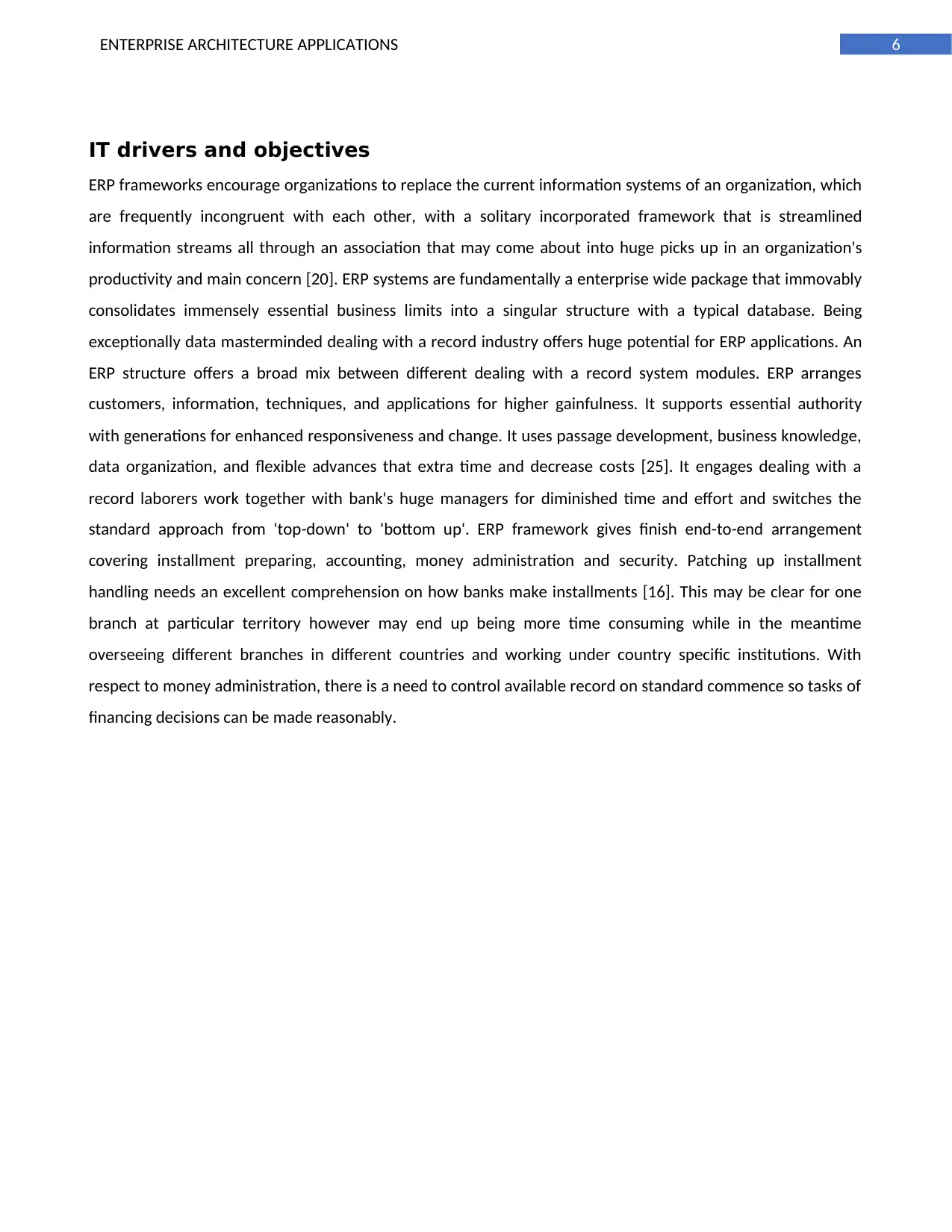
6ENTERPRISE ARCHITECTURE APPLICATIONS
IT drivers and objectives
ERP frameworks encourage organizations to replace the current information systems of an organization, which
are frequently incongruent with each other, with a solitary incorporated framework that is streamlined
information streams all through an association that may come about into huge picks up in an organization's
productivity and main concern [20]. ERP systems are fundamentally a enterprise wide package that immovably
consolidates immensely essential business limits into a singular structure with a typical database. Being
exceptionally data masterminded dealing with a record industry offers huge potential for ERP applications. An
ERP structure offers a broad mix between different dealing with a record system modules. ERP arranges
customers, information, techniques, and applications for higher gainfulness. It supports essential authority
with generations for enhanced responsiveness and change. It uses passage development, business knowledge,
data organization, and flexible advances that extra time and decrease costs [25]. It engages dealing with a
record laborers work together with bank's huge managers for diminished time and effort and switches the
standard approach from 'top-down' to 'bottom up'. ERP framework gives finish end-to-end arrangement
covering installment preparing, accounting, money administration and security. Patching up installment
handling needs an excellent comprehension on how banks make installments [16]. This may be clear for one
branch at particular territory however may end up being more time consuming while in the meantime
overseeing different branches in different countries and working under country specific institutions. With
respect to money administration, there is a need to control available record on standard commence so tasks of
financing decisions can be made reasonably.
IT drivers and objectives
ERP frameworks encourage organizations to replace the current information systems of an organization, which
are frequently incongruent with each other, with a solitary incorporated framework that is streamlined
information streams all through an association that may come about into huge picks up in an organization's
productivity and main concern [20]. ERP systems are fundamentally a enterprise wide package that immovably
consolidates immensely essential business limits into a singular structure with a typical database. Being
exceptionally data masterminded dealing with a record industry offers huge potential for ERP applications. An
ERP structure offers a broad mix between different dealing with a record system modules. ERP arranges
customers, information, techniques, and applications for higher gainfulness. It supports essential authority
with generations for enhanced responsiveness and change. It uses passage development, business knowledge,
data organization, and flexible advances that extra time and decrease costs [25]. It engages dealing with a
record laborers work together with bank's huge managers for diminished time and effort and switches the
standard approach from 'top-down' to 'bottom up'. ERP framework gives finish end-to-end arrangement
covering installment preparing, accounting, money administration and security. Patching up installment
handling needs an excellent comprehension on how banks make installments [16]. This may be clear for one
branch at particular territory however may end up being more time consuming while in the meantime
overseeing different branches in different countries and working under country specific institutions. With
respect to money administration, there is a need to control available record on standard commence so tasks of
financing decisions can be made reasonably.
Paraphrase This Document
Need a fresh take? Get an instant paraphrase of this document with our AI Paraphraser
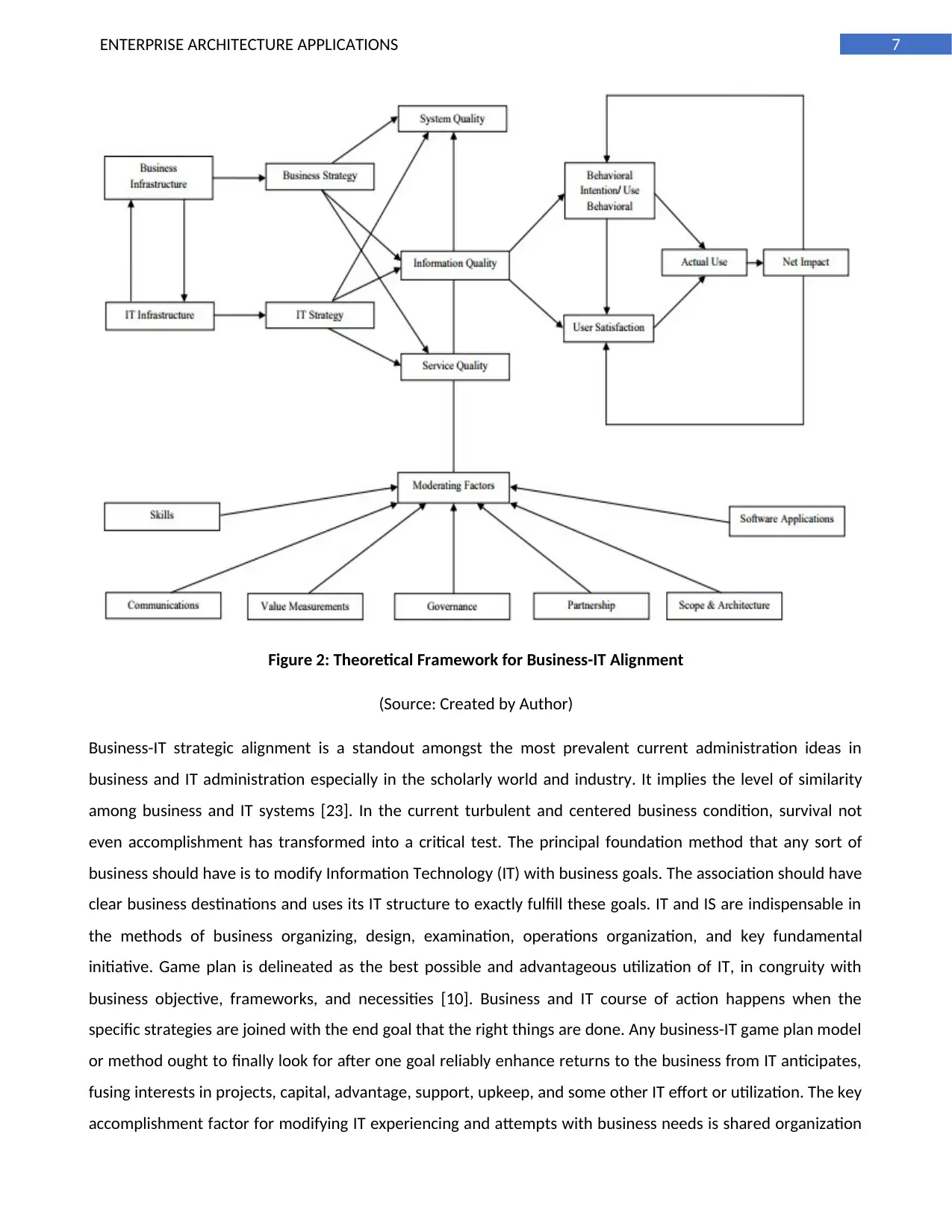
7ENTERPRISE ARCHITECTURE APPLICATIONS
Figure 2: Theoretical Framework for Business-IT Alignment
(Source: Created by Author)
Business-IT strategic alignment is a standout amongst the most prevalent current administration ideas in
business and IT administration especially in the scholarly world and industry. It implies the level of similarity
among business and IT systems [23]. In the current turbulent and centered business condition, survival not
even accomplishment has transformed into a critical test. The principal foundation method that any sort of
business should have is to modify Information Technology (IT) with business goals. The association should have
clear business destinations and uses its IT structure to exactly fulfill these goals. IT and IS are indispensable in
the methods of business organizing, design, examination, operations organization, and key fundamental
initiative. Game plan is delineated as the best possible and advantageous utilization of IT, in congruity with
business objective, frameworks, and necessities [10]. Business and IT course of action happens when the
specific strategies are joined with the end goal that the right things are done. Any business-IT game plan model
or method ought to finally look for after one goal reliably enhance returns to the business from IT anticipates,
fusing interests in projects, capital, advantage, support, upkeep, and some other IT effort or utilization. The key
accomplishment factor for modifying IT experiencing and attempts with business needs is shared organization
Figure 2: Theoretical Framework for Business-IT Alignment
(Source: Created by Author)
Business-IT strategic alignment is a standout amongst the most prevalent current administration ideas in
business and IT administration especially in the scholarly world and industry. It implies the level of similarity
among business and IT systems [23]. In the current turbulent and centered business condition, survival not
even accomplishment has transformed into a critical test. The principal foundation method that any sort of
business should have is to modify Information Technology (IT) with business goals. The association should have
clear business destinations and uses its IT structure to exactly fulfill these goals. IT and IS are indispensable in
the methods of business organizing, design, examination, operations organization, and key fundamental
initiative. Game plan is delineated as the best possible and advantageous utilization of IT, in congruity with
business objective, frameworks, and necessities [10]. Business and IT course of action happens when the
specific strategies are joined with the end goal that the right things are done. Any business-IT game plan model
or method ought to finally look for after one goal reliably enhance returns to the business from IT anticipates,
fusing interests in projects, capital, advantage, support, upkeep, and some other IT effort or utilization. The key
accomplishment factor for modifying IT experiencing and attempts with business needs is shared organization
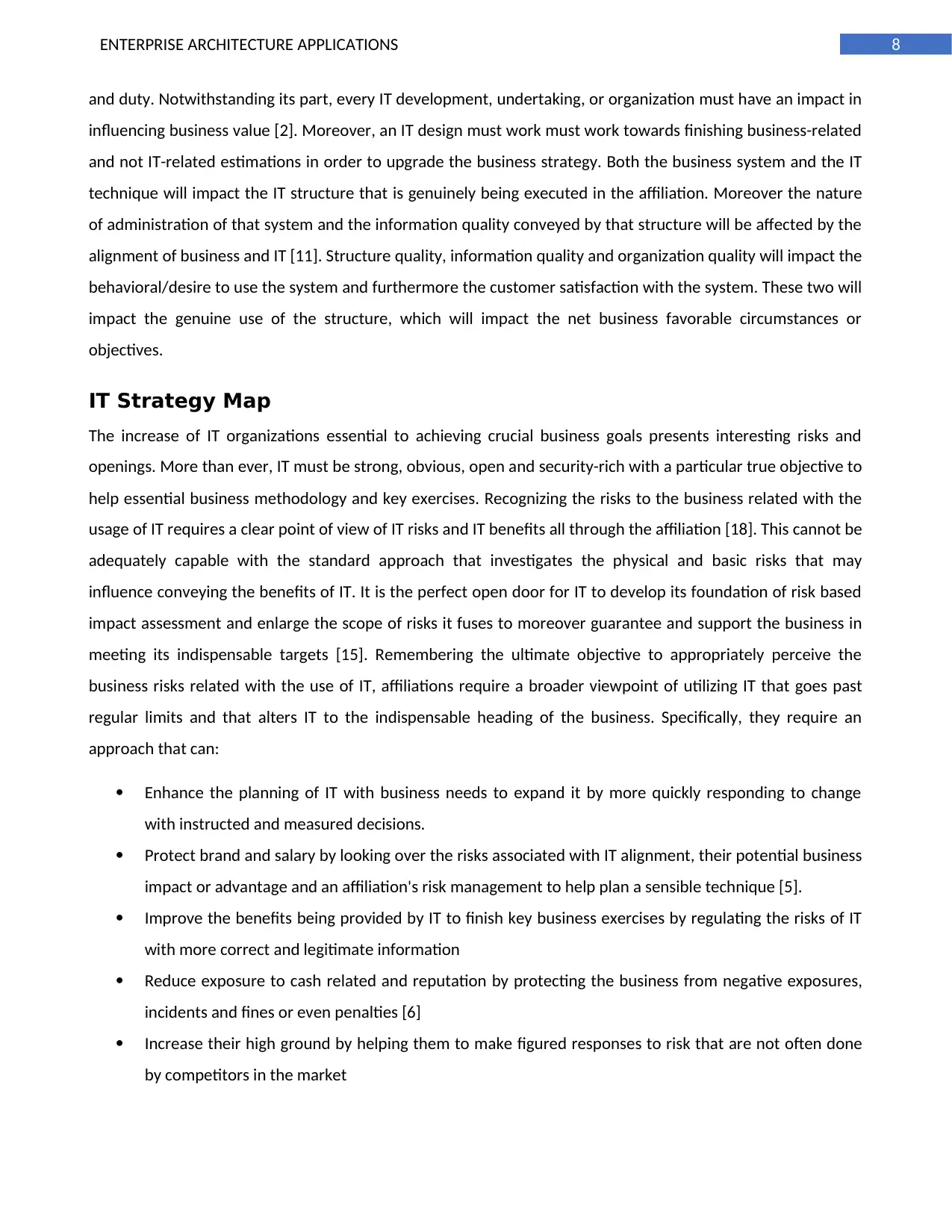
8ENTERPRISE ARCHITECTURE APPLICATIONS
and duty. Notwithstanding its part, every IT development, undertaking, or organization must have an impact in
influencing business value [2]. Moreover, an IT design must work must work towards finishing business-related
and not IT-related estimations in order to upgrade the business strategy. Both the business system and the IT
technique will impact the IT structure that is genuinely being executed in the affiliation. Moreover the nature
of administration of that system and the information quality conveyed by that structure will be affected by the
alignment of business and IT [11]. Structure quality, information quality and organization quality will impact the
behavioral/desire to use the system and furthermore the customer satisfaction with the system. These two will
impact the genuine use of the structure, which will impact the net business favorable circumstances or
objectives.
IT Strategy Map
The increase of IT organizations essential to achieving crucial business goals presents interesting risks and
openings. More than ever, IT must be strong, obvious, open and security-rich with a particular true objective to
help essential business methodology and key exercises. Recognizing the risks to the business related with the
usage of IT requires a clear point of view of IT risks and IT benefits all through the affiliation [18]. This cannot be
adequately capable with the standard approach that investigates the physical and basic risks that may
influence conveying the benefits of IT. It is the perfect open door for IT to develop its foundation of risk based
impact assessment and enlarge the scope of risks it fuses to moreover guarantee and support the business in
meeting its indispensable targets [15]. Remembering the ultimate objective to appropriately perceive the
business risks related with the use of IT, affiliations require a broader viewpoint of utilizing IT that goes past
regular limits and that alters IT to the indispensable heading of the business. Specifically, they require an
approach that can:
Enhance the planning of IT with business needs to expand it by more quickly responding to change
with instructed and measured decisions.
Protect brand and salary by looking over the risks associated with IT alignment, their potential business
impact or advantage and an affiliation's risk management to help plan a sensible technique [5].
Improve the benefits being provided by IT to finish key business exercises by regulating the risks of IT
with more correct and legitimate information
Reduce exposure to cash related and reputation by protecting the business from negative exposures,
incidents and fines or even penalties [6]
Increase their high ground by helping them to make figured responses to risk that are not often done
by competitors in the market
and duty. Notwithstanding its part, every IT development, undertaking, or organization must have an impact in
influencing business value [2]. Moreover, an IT design must work must work towards finishing business-related
and not IT-related estimations in order to upgrade the business strategy. Both the business system and the IT
technique will impact the IT structure that is genuinely being executed in the affiliation. Moreover the nature
of administration of that system and the information quality conveyed by that structure will be affected by the
alignment of business and IT [11]. Structure quality, information quality and organization quality will impact the
behavioral/desire to use the system and furthermore the customer satisfaction with the system. These two will
impact the genuine use of the structure, which will impact the net business favorable circumstances or
objectives.
IT Strategy Map
The increase of IT organizations essential to achieving crucial business goals presents interesting risks and
openings. More than ever, IT must be strong, obvious, open and security-rich with a particular true objective to
help essential business methodology and key exercises. Recognizing the risks to the business related with the
usage of IT requires a clear point of view of IT risks and IT benefits all through the affiliation [18]. This cannot be
adequately capable with the standard approach that investigates the physical and basic risks that may
influence conveying the benefits of IT. It is the perfect open door for IT to develop its foundation of risk based
impact assessment and enlarge the scope of risks it fuses to moreover guarantee and support the business in
meeting its indispensable targets [15]. Remembering the ultimate objective to appropriately perceive the
business risks related with the use of IT, affiliations require a broader viewpoint of utilizing IT that goes past
regular limits and that alters IT to the indispensable heading of the business. Specifically, they require an
approach that can:
Enhance the planning of IT with business needs to expand it by more quickly responding to change
with instructed and measured decisions.
Protect brand and salary by looking over the risks associated with IT alignment, their potential business
impact or advantage and an affiliation's risk management to help plan a sensible technique [5].
Improve the benefits being provided by IT to finish key business exercises by regulating the risks of IT
with more correct and legitimate information
Reduce exposure to cash related and reputation by protecting the business from negative exposures,
incidents and fines or even penalties [6]
Increase their high ground by helping them to make figured responses to risk that are not often done
by competitors in the market
⊘ This is a preview!⊘
Do you want full access?
Subscribe today to unlock all pages.

Trusted by 1+ million students worldwide

9ENTERPRISE ARCHITECTURE APPLICATIONS
By tying great risk methods specifically to vital business activities, associations would more be able to
effortlessly report key performance indicators (KPIs) and key risk indicators (KRIs) and organize risks in light of
their effect on or commitment to key objectives [21]. Moreover, the business is better ready to execute
adjusted risk administration designs, utilize clear correspondence designs and constantly screen chance
markers. The usage of any innovation cannot be fruitful ideal from the earliest starting point as risks are
included. The initial step included is to roll out this mechanical improvement justifiable by people and
henceforth the test is before CBA to guarantee appropriate preparing to their workers. For that reason,
uncommon authorities must be utilized. Preparing must be given on worker's right side from the day when
innovation is sent. This is a key stride in keeping up merchant connections. Incorporating this mechanical
change with the current framework is the real obstacle which is to be eliminated [23]. The greatest test which
SAP platform has is to guarantee Straight through Processing (known as STP in corporate section) of different
money related exchanges. With the CBA having many organizations under its immense corporate umbrella.
SAP platform must be coordinated with different corporate wide applications like Credit Card, Mobile money,
common assets, business, call focus and different applications occurring at the same time. In context to the
particular scenario of banking industry, ERP is very helpful to plan operations, technical along with making
decisions for strategic planning. ERP system will help to carry out various number of responsibilities that are
required functions of accounting and financial management in the banking industry.
Conclusion
From above study on the case of Commonwealth Bank of Australia (CBA), it has been identified that
implementation of technological advancements will play a major role in growth of the financial institution. A
very scalable and adaptable innovation stage is fundamental for associations to oversee development and
contend effectively, for example, SAP in this specific setting. The main IT Core Banking Solution will enable
Commonwealth Bank of Australia to accomplish its goals over the system. The current issues and difficulties
being confronted by CBA can be settled with the assistance of SAP platform. In this way, putting resources into
innovation will help CBA to get rich profits. The bank can effectively utilize SAP platform and effectively figure
out how to send the arrangement in the zones of center keeping money, buyer driven e-saving money
(Electronic B 2 C fragment), coordinate saving money, corporate e-saving money (Electronic B 2 B segment)
and Customer Relationship Management. Therefore, SAP platform can ensure adaptability to accomplish
appropriate division. This will help CBA to develop its market and have some edge over the opposition. The
bank can make utilization of core technology as a key differentiator, along these lines rethinking the principles
of managing an account and moreover likewise demonstrating how innovation can benefit some in changing
the business of a bank.
By tying great risk methods specifically to vital business activities, associations would more be able to
effortlessly report key performance indicators (KPIs) and key risk indicators (KRIs) and organize risks in light of
their effect on or commitment to key objectives [21]. Moreover, the business is better ready to execute
adjusted risk administration designs, utilize clear correspondence designs and constantly screen chance
markers. The usage of any innovation cannot be fruitful ideal from the earliest starting point as risks are
included. The initial step included is to roll out this mechanical improvement justifiable by people and
henceforth the test is before CBA to guarantee appropriate preparing to their workers. For that reason,
uncommon authorities must be utilized. Preparing must be given on worker's right side from the day when
innovation is sent. This is a key stride in keeping up merchant connections. Incorporating this mechanical
change with the current framework is the real obstacle which is to be eliminated [23]. The greatest test which
SAP platform has is to guarantee Straight through Processing (known as STP in corporate section) of different
money related exchanges. With the CBA having many organizations under its immense corporate umbrella.
SAP platform must be coordinated with different corporate wide applications like Credit Card, Mobile money,
common assets, business, call focus and different applications occurring at the same time. In context to the
particular scenario of banking industry, ERP is very helpful to plan operations, technical along with making
decisions for strategic planning. ERP system will help to carry out various number of responsibilities that are
required functions of accounting and financial management in the banking industry.
Conclusion
From above study on the case of Commonwealth Bank of Australia (CBA), it has been identified that
implementation of technological advancements will play a major role in growth of the financial institution. A
very scalable and adaptable innovation stage is fundamental for associations to oversee development and
contend effectively, for example, SAP in this specific setting. The main IT Core Banking Solution will enable
Commonwealth Bank of Australia to accomplish its goals over the system. The current issues and difficulties
being confronted by CBA can be settled with the assistance of SAP platform. In this way, putting resources into
innovation will help CBA to get rich profits. The bank can effectively utilize SAP platform and effectively figure
out how to send the arrangement in the zones of center keeping money, buyer driven e-saving money
(Electronic B 2 C fragment), coordinate saving money, corporate e-saving money (Electronic B 2 B segment)
and Customer Relationship Management. Therefore, SAP platform can ensure adaptability to accomplish
appropriate division. This will help CBA to develop its market and have some edge over the opposition. The
bank can make utilization of core technology as a key differentiator, along these lines rethinking the principles
of managing an account and moreover likewise demonstrating how innovation can benefit some in changing
the business of a bank.
Paraphrase This Document
Need a fresh take? Get an instant paraphrase of this document with our AI Paraphraser

10ENTERPRISE ARCHITECTURE APPLICATIONS
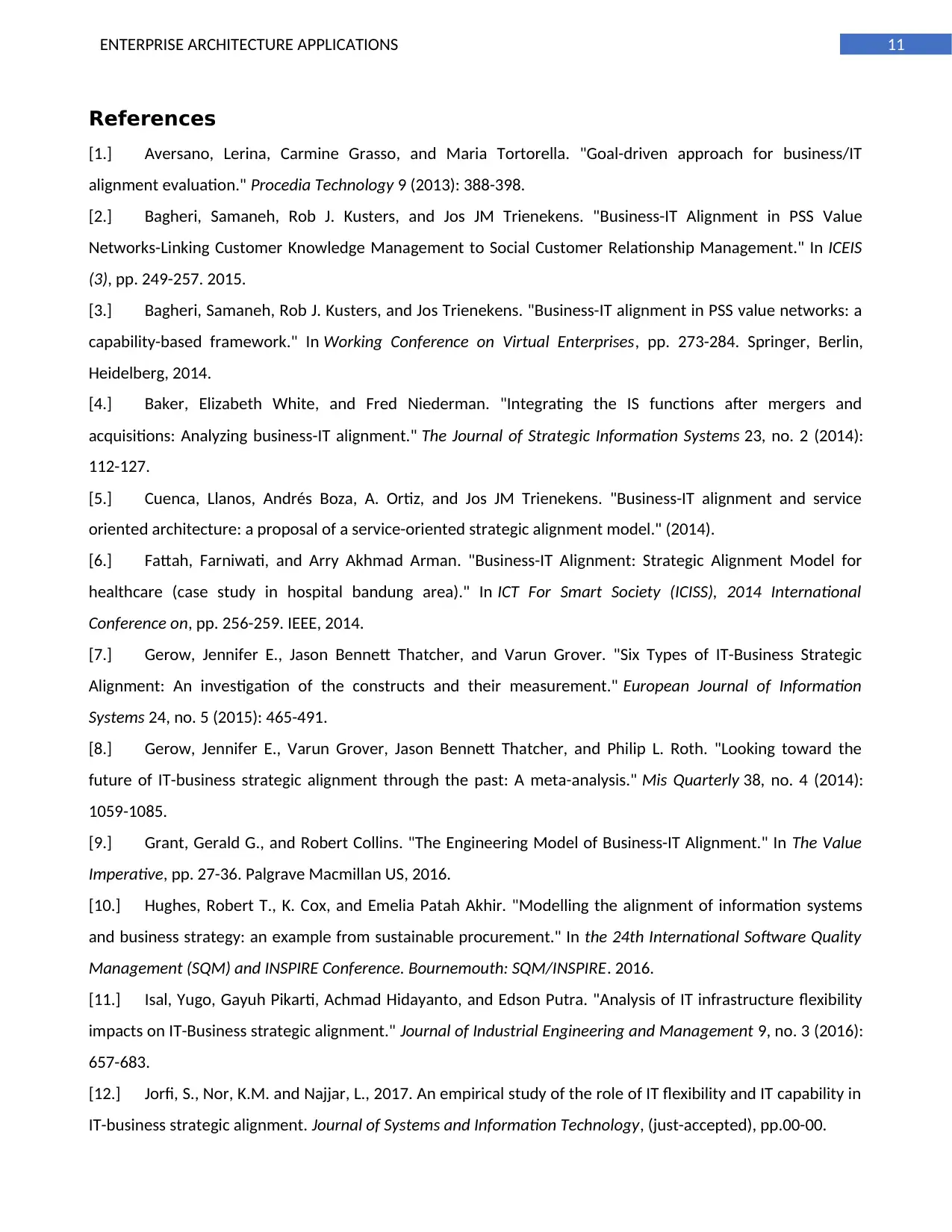
11ENTERPRISE ARCHITECTURE APPLICATIONS
References
[1.] Aversano, Lerina, Carmine Grasso, and Maria Tortorella. "Goal-driven approach for business/IT
alignment evaluation." Procedia Technology 9 (2013): 388-398.
[2.] Bagheri, Samaneh, Rob J. Kusters, and Jos JM Trienekens. "Business-IT Alignment in PSS Value
Networks-Linking Customer Knowledge Management to Social Customer Relationship Management." In ICEIS
(3), pp. 249-257. 2015.
[3.] Bagheri, Samaneh, Rob J. Kusters, and Jos Trienekens. "Business-IT alignment in PSS value networks: a
capability-based framework." In Working Conference on Virtual Enterprises, pp. 273-284. Springer, Berlin,
Heidelberg, 2014.
[4.] Baker, Elizabeth White, and Fred Niederman. "Integrating the IS functions after mergers and
acquisitions: Analyzing business-IT alignment." The Journal of Strategic Information Systems 23, no. 2 (2014):
112-127.
[5.] Cuenca, Llanos, Andrés Boza, A. Ortiz, and Jos JM Trienekens. "Business-IT alignment and service
oriented architecture: a proposal of a service-oriented strategic alignment model." (2014).
[6.] Fattah, Farniwati, and Arry Akhmad Arman. "Business-IT Alignment: Strategic Alignment Model for
healthcare (case study in hospital bandung area)." In ICT For Smart Society (ICISS), 2014 International
Conference on, pp. 256-259. IEEE, 2014.
[7.] Gerow, Jennifer E., Jason Bennett Thatcher, and Varun Grover. "Six Types of IT-Business Strategic
Alignment: An investigation of the constructs and their measurement." European Journal of Information
Systems 24, no. 5 (2015): 465-491.
[8.] Gerow, Jennifer E., Varun Grover, Jason Bennett Thatcher, and Philip L. Roth. "Looking toward the
future of IT-business strategic alignment through the past: A meta-analysis." Mis Quarterly 38, no. 4 (2014):
1059-1085.
[9.] Grant, Gerald G., and Robert Collins. "The Engineering Model of Business-IT Alignment." In The Value
Imperative, pp. 27-36. Palgrave Macmillan US, 2016.
[10.] Hughes, Robert T., K. Cox, and Emelia Patah Akhir. "Modelling the alignment of information systems
and business strategy: an example from sustainable procurement." In the 24th International Software Quality
Management (SQM) and INSPIRE Conference. Bournemouth: SQM/INSPIRE. 2016.
[11.] Isal, Yugo, Gayuh Pikarti, Achmad Hidayanto, and Edson Putra. "Analysis of IT infrastructure flexibility
impacts on IT-Business strategic alignment." Journal of Industrial Engineering and Management 9, no. 3 (2016):
657-683.
[12.] Jorfi, S., Nor, K.M. and Najjar, L., 2017. An empirical study of the role of IT flexibility and IT capability in
IT-business strategic alignment. Journal of Systems and Information Technology, (just-accepted), pp.00-00.
References
[1.] Aversano, Lerina, Carmine Grasso, and Maria Tortorella. "Goal-driven approach for business/IT
alignment evaluation." Procedia Technology 9 (2013): 388-398.
[2.] Bagheri, Samaneh, Rob J. Kusters, and Jos JM Trienekens. "Business-IT Alignment in PSS Value
Networks-Linking Customer Knowledge Management to Social Customer Relationship Management." In ICEIS
(3), pp. 249-257. 2015.
[3.] Bagheri, Samaneh, Rob J. Kusters, and Jos Trienekens. "Business-IT alignment in PSS value networks: a
capability-based framework." In Working Conference on Virtual Enterprises, pp. 273-284. Springer, Berlin,
Heidelberg, 2014.
[4.] Baker, Elizabeth White, and Fred Niederman. "Integrating the IS functions after mergers and
acquisitions: Analyzing business-IT alignment." The Journal of Strategic Information Systems 23, no. 2 (2014):
112-127.
[5.] Cuenca, Llanos, Andrés Boza, A. Ortiz, and Jos JM Trienekens. "Business-IT alignment and service
oriented architecture: a proposal of a service-oriented strategic alignment model." (2014).
[6.] Fattah, Farniwati, and Arry Akhmad Arman. "Business-IT Alignment: Strategic Alignment Model for
healthcare (case study in hospital bandung area)." In ICT For Smart Society (ICISS), 2014 International
Conference on, pp. 256-259. IEEE, 2014.
[7.] Gerow, Jennifer E., Jason Bennett Thatcher, and Varun Grover. "Six Types of IT-Business Strategic
Alignment: An investigation of the constructs and their measurement." European Journal of Information
Systems 24, no. 5 (2015): 465-491.
[8.] Gerow, Jennifer E., Varun Grover, Jason Bennett Thatcher, and Philip L. Roth. "Looking toward the
future of IT-business strategic alignment through the past: A meta-analysis." Mis Quarterly 38, no. 4 (2014):
1059-1085.
[9.] Grant, Gerald G., and Robert Collins. "The Engineering Model of Business-IT Alignment." In The Value
Imperative, pp. 27-36. Palgrave Macmillan US, 2016.
[10.] Hughes, Robert T., K. Cox, and Emelia Patah Akhir. "Modelling the alignment of information systems
and business strategy: an example from sustainable procurement." In the 24th International Software Quality
Management (SQM) and INSPIRE Conference. Bournemouth: SQM/INSPIRE. 2016.
[11.] Isal, Yugo, Gayuh Pikarti, Achmad Hidayanto, and Edson Putra. "Analysis of IT infrastructure flexibility
impacts on IT-Business strategic alignment." Journal of Industrial Engineering and Management 9, no. 3 (2016):
657-683.
[12.] Jorfi, S., Nor, K.M. and Najjar, L., 2017. An empirical study of the role of IT flexibility and IT capability in
IT-business strategic alignment. Journal of Systems and Information Technology, (just-accepted), pp.00-00.
⊘ This is a preview!⊘
Do you want full access?
Subscribe today to unlock all pages.

Trusted by 1+ million students worldwide
1 out of 13
Related Documents
Your All-in-One AI-Powered Toolkit for Academic Success.
+13062052269
info@desklib.com
Available 24*7 on WhatsApp / Email
![[object Object]](/_next/static/media/star-bottom.7253800d.svg)
Unlock your academic potential
Copyright © 2020–2025 A2Z Services. All Rights Reserved. Developed and managed by ZUCOL.




